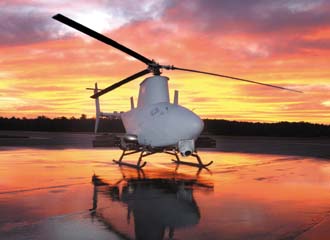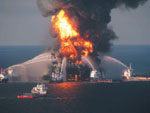Diverse Duties Drive Technology Development
 |
One of the U.S. Coast Guard’s many research and development efforts focuses on the U.S. Navy’s Fire Scout vertical take-off unmanned system. |
Nearly 10 years after the September 11, 2001, terrorist attacks, requirements at the U.S. Coast Guard’s Research and Development Center in New London, Connecticut, are still being driven in part by the mission to combat terrorism and the resulting need for maritime domain awareness. To support these Coast Guard goals, the Research, Development, Test and Evaluation program’s priorities have grown significantly in the area of command, control, communications, computers, intelligence, surveillance and reconnaissance.
But combating terrorism is only one of many Coast Guard missions, and the maritime service continually searches for technologies to improve awareness in an unusually wide range of situations. As the guardian of the U.S. shoreline in peacetime, the Coast Guard is responsible for a plethora of missions, including maritime safety, drug interdiction, immigrant interdiction, and search and rescue operations. Because it can be attached to the U.S. Defense Department in wartime, it also has defense readiness responsibilities. Other missions include fighting terrorism and piracy and organizing a rapid response to other disasters, natural or manmade. That conglomeration of responsibilities drives the Coast Guard’s broad spectrum of technology research and development efforts, which includes unmanned aerial vehicles (UAVs), biometrics and oil cleanup technologies.
Research is taking place in two broad categories: developing and applying new or better sensors to conduct surveillance, detection, identification and classification of vessels and cargo; and turning that data into information and subsequently into actionable knowledge. “We’re looking at how to more effectively transmit ultrahigh frequency for operational communications. We’re looking at crew communications systems to facilitate communication between crewmembers on small boats and cutters. We’re looking at how to more effectively transmit and utilize data from unmanned aerial systems,” says Capt. Austin Gould, USCG, Research, Development, Test and Evaluation program manager. “Unmanned vehicles used correctly can provide an enormous amount of data, but that data’s only good if you can get it into the hands of the operators, who are actually looking at it and can understand what they’re looking at so that they can make decisions.”
The Research and Development Center, which may have as many as 80 ongoing projects at any given time, is the Coast Guard’s sole facility performing research, development, test and evaluation to support the service’s major missions. Research and development efforts focus on technologies that will provide incremental improvements, as well as those with the greatest potential to transform strategically the way the Coast Guard does business. The center is responsible for evaluating the feasibility and affordability of technologies and systems and providing operational and risk-management analysis at all stages of the acquisition process.
With a tight budget available for research and development, the Coast Guard works closely with the U.S. Department of Homeland Security (DHS), the U.S. Defense Department and other agencies to find solutions. “What we do at the Research and Development Center is all geared toward advancing Coast Guard knowledge of emerging technologies. We do pre-acquisition support in terms of alternatives analysis to look at the realm of the possible,” Capt. Gould says. “We basically do applied research and development. We look at ideas developed elsewhere and see how they fit into the Coast Guard portfolio.”
Capt. Gould cites UAVs as a perfect example of cooperation with other agencies. “Unmanned aerial systems provide enhanced detection and identification capabilities for ships. They’re a big thing for the Department of Defense, and the Coast Guard in the last five or six years is really starting to look at unmanned aerial systems as potential capabilities that we could use to more effectively execute our missions,” he says.
In an effort to enhance maritime domain awareness, the service has evaluated several unmanned aircraft over the past several years, including the RQ-8 Fire Scout, MQ-9 Predator A and Predator B, as well as the Sentry small unmanned aerial system. The Coast Guard deployed the Condor UAV on the Harriet Lane cutter vessel in early 2001 and continues to seek opportunities for cooperative testing with the DHS and Defense Department.
Currently, the service is studying the cost effectiveness of tactical UAVs for deployment on its National Security Cutter, which would extend the vessel’s surveillance capabilities. The Coast Guard also is studying tactical, land-based systems to provide a surveillance capability comparable to manned maritime patrol aircraft. Both land- and cutter-based systems are expected to include maritime radar, electro-optical sensors and an automatic identification system. The systems are expected to perform surveillance, detection, classification and target identification functions. “Unmanned aerial systems are a top priority for us,” Capt. Gould says.
The Coast Guard has yet to purchase any unmanned aircraft of its own but shares a modified Predator B known as Guardian with the U.S. Customs and Border Protection agency, which also falls under the DHS umbrella. Guardian features an automatic identification system, electro-optical, infrared camera and a sea search radar capability with inverse synthetic aperture radar. Although unarmed, Guardian includes a multispectral targeting system able to see through sea haze to read the letters on the side of a vessel. The Coast Guard is interested in a similar system capable of flying more than 9,000 surveillance hours per year.
 |
The Deepwater Horizon oil spill made last year unique for the U.S. Coast Guard, which continues to research technologies for oil spill cleanup. |
The DHS approved the Coast Guard’s unmanned aircraft system strategy to acquire land- and cutter-based systems, while emphasizing commonality with existing DHS and Department of Defense programs, says Gary Dehnel, Coast Guard project manager for unmanned aircraft acquisition. “The Coast Guard’s land- and cutter-based unmanned aerial system projects are in the pre-acquisition phase. Passing the milestone to move into the formal acquisition phase is dependent on future funding.”
As it does with UAVs, the Coast Guard works closely with the Defense Department and other agencies to get biometrics technologies to the field. The service started a pilot program in 2006 to use biometric technologies to identify and track illegal immigrants attempting to enter U.S. territory through the Mona Passage, the body of water between the Dominican Republic and Puerto Rico. Illegal immigrant flow through the passage since has been reduced by about 75 percent.
In addition, the service participates in the Transportation Security Administration’s Transportation Worker Identification Credential program. The program issues identification cards with biometrics data to transportation workers, and the Coast Guard distributes them to employees on the docks and on the water.
In the U.S. Central Command area of responsibility, the Coast Guard uses biometrics to identify suspected insurgents. The 2010 Coast Guard Authorization Act authorizes a limited expansion of the service’s biometrics programs, according to Cmdr. Scott Rogers, USCG, deputy chief in the Office of Counterterrorism and Defense Operations. However, current biometrics technologies are less than ideal in a maritime environment. “Our biometrics programs are fledgling in a maritime environment, in part because there’s low demand for the development of a device that works really well in a salt spray environment,” Cmdr. Rogers says.
He explains that although the government is spending billions of dollars on biometrics technologies, the Navy and Coast Guard are the only two agencies with a need for maritime biometrics, and they have not funded development in large part because of the limited bandwidth available at sea. The communications pipes are too narrow to transmit large files such as iris scans without compressing them and possibly degrading the data. “Right now, most of the biometrics systems don’t use any real data compression techniques for packet management, other than those built into the communications pipeline itself. In terms of shrinking the file size overall, that’s a little harder from a legal and technical perspective because when you’re dealing with a graphics-based file, you want the details for an accurate identification,” Cmdr. Rogers says.
In addition to protecting the coast, the service is responsible for responding to environmental disasters such as the Deepwater Horizon oil spill, another mission that influences its research and development efforts. For example, Coast Guard researchers had developed the majority of in situ burning techniques that were used during the spill to eliminate surface oil and minimize the environmental impact.
Coast Guard researchers were somewhat prepared when the Deepwater Horizon well exploded and began spewing millions of gallons of oil into the Gulf of Mexico. “We already had a program underway looking at submerged oil detection and recovery. While we were not talking the depths of the Deepwater Horizon spill, we at least had some knowledge of technologies out there that could help with underwater plume detection and plume mapping, which was a large component of the Deepwater Horizon spill,” Capt. Gould explains. “Based on the Deepwater Horizon spill, we’ve expanded our research and development efforts to include marsh cleaning technologies and underwater detection, underwater recovery, trajectory analysis and how to mitigate shoreline impacts.”
In response to the spill, the Coast Guard Research and Development Center established a systematic effort to evaluate and quickly field alternative response technologies. “We got more than 4,000 submissions. Every one of those submissions was catalogued, categorized and evaluated. The most applicable technologies were forwarded to the federal on-scene coordinator. Should funding become available, we would be able to continue to research the rest of those 4,000 ideas that weren’t used during the spill. We would like to use that as a basis for oil spill research going forward,” the captain reveals. He adds that because of the oil spill, “Last year was a very unique year for the Coast Guard.” And just in case talks of oil or natural gas exploration in the Arctic come to fruition one day, the service has been investigating the unique challenges associated with an oil spill in an icy environment.
Major events such as the 9/11 attacks and last year’s oil spill may add to the Coast Guard’s research and development requirements, but those expanded requirements do not always translate into additional funding. “Our research requirements far exceed the amount of funding we have available,” Capt. Gould states. “Our research and development budget is only $20 million, and there are consistently requirements we can’t address.”
WEB RESOURCES
U.S. Coast Guard Research and Development Center: www.uscg.mil/acquisition/rdc/rdc.asp
Coast Guard Research areas and projects: www.uscg.mil/acquisition/rdc/programs.asp




Comments